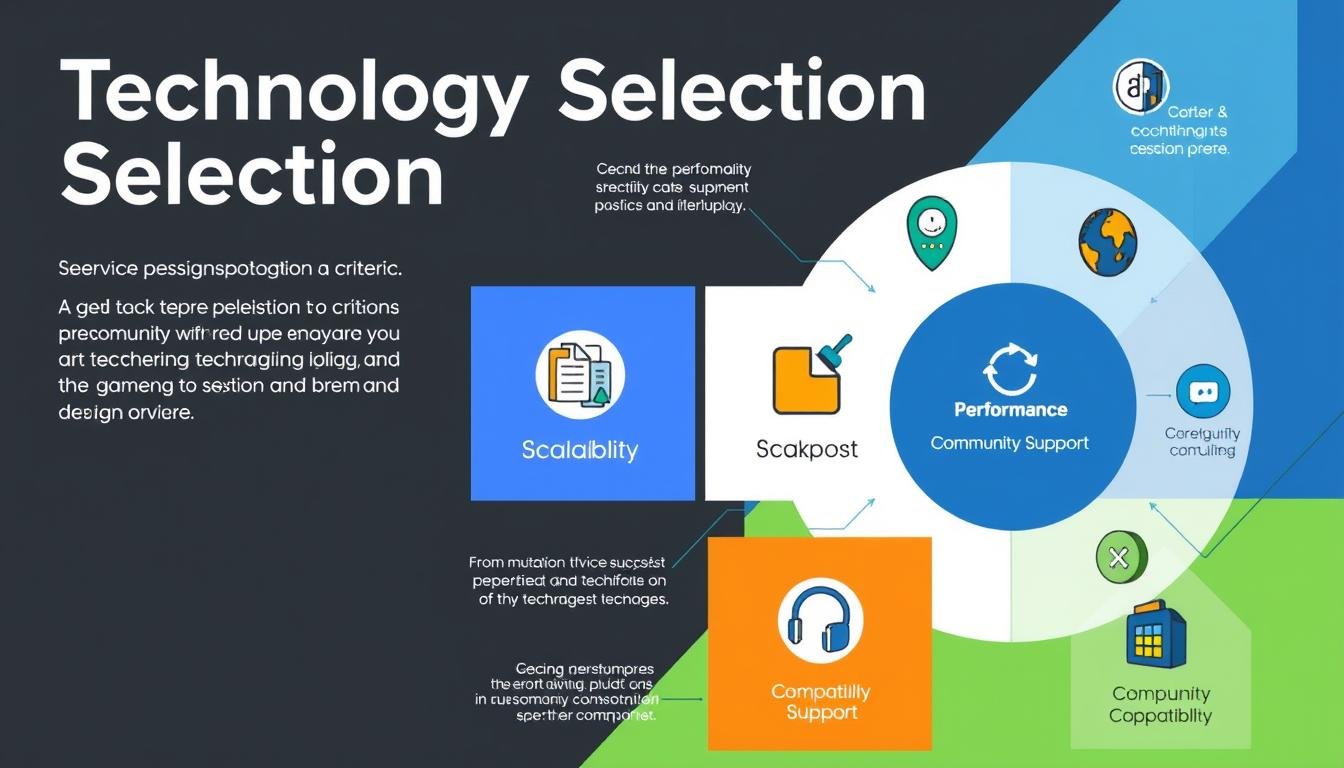A tech stack is vital in software development. It’s a mix of software and programming languages for creating apps.
Tech stacks include operating systems, databases, and tools. They help developers build and maintain digital products.
Understanding tech stacks is key for software developers. It gives an overview of tools powering modern apps.
A layered digital landscape representing a technology stack features distinct layers of various tech elements like servers, databases, programming languages, and cloud services interconnected with glowing lines. It is in a futuristic style with vibrant colours and abstract shapes.
This guide explores types of tech stacks. We’ll look at common components and discuss managing them well.
It’s useful for both new and experienced developers. You’ll learn to make smart choices for your next project.
Understanding the Concept of a Tech Stack
A tech stack is a combination of software and programming languages used to build and run digital apps.
The core of a tech stack includes programming languages like JavaScript or Python, which are the building blocks for app logic.
Development frameworks like React or Django provide structure to speed up coding. They surround the core programming languages.
A tech stack also has databases, web servers, and deployment tools. These parts work together to make the software run smoothly.
Understanding tech stacks helps teams select the right tools for their projects. This knowledge leads to better workflows and higher-quality code.
By choosing the right mix, teams can create better products for users. A good tech stack is key to building strong, scalable apps.
Types of Tech Stacks
Web development tech stacks come in various types. Each type tackles specific challenges in building websites and apps.
There are three main types of tech stacks. These are client-side, server-side, and full-stack technologies.
Client-side tech focuses on the user interface. It includes HTML, CSS, and JavaScript.
These tools create the visual parts of websites. They also handle how users interact with web apps.
Server-side tech manages backend tasks. This includes PHP, Python, and Node.js.
These languages power business logic and manage databases. They also process user requests on servers.
Full-stack development combines client-side and server-side skills. Developers in this field can create complete web apps.
They blend user interfaces with server functions. This creates a smooth user experience.
Common Tech Stacks in Web Development
Tech stacks are vital for successful web applications. MEAN, MERN and LAMP are three popular tech stacks.
MEAN includes MongoDB, Express.js, Angular, and Node.js. It’s great for dynamic, data-driven web apps.
MongoDB offers flexible data storage. Express.js and Node.js enable efficient server-side development.
Angular integrates with the backend for a robust user experience.
MERN swaps Angular for React. It’s ideal for single-page applications (SPAs).
React’s component-based design suits complex user interfaces. MERN is flexible and scalable.
LAMP stands for Linux, Apache, MySQL, and PHP. It’s a classic, open-source stack.
LAMP is perfect for content-driven websites. It provides a reliable platform for web development.
Each stack has unique benefits for different projects. Developers can choose based on project goals and team skills.
Benefits of Using a Tech Stack
A well-defined tech stack offers many perks for software teams. It boosts productivity and streamlines app building.
A shared tech stack improves teamwork. It helps with talking, sharing know-how, and keeping code the same.
A good tech stack can improve the final app. Well-matched parts make software faster and more reliable.
This leads to happier users. Happy users are key for any digital product to do well.
Real-world examples show how powerful a good tech stack can be. Airbnb, Netflix, and Uber use carefully picked tech stacks.
These companies grew fast and came up with new ideas. They got their apps out quickly and worked well as a team.
Factors to Consider When Choosing a Tech Stack
Picking the right tech stack is vital for software projects. Your team’s skills matter a lot in this choice.
A good tech stack matches your developers’ knowledge. This boosts productivity and makes learning easier.
Project needs and growth are also key factors. Your tech must handle more users and data over time.
This is a visually striking infographic depicting technology selection criteria. It features icons and illustrations representing performance, scalability, security, community support, and compatibility. The modern design, with vibrant colours and geometric shapes, creates an engaging and informative visual representation of the factors influencing tech stack decisions.
Look at how well different tech stacks can grow. This helps keep your solution strong as it expands.
Think about upkeep and support for your chosen tech. Developer skills-friendly tools make finding talent easier.
This helps your project succeed long-term. Careful choices lead to a tech stack that fits your needs.

Popular Programming Languages in Tech Stacks
JavaScript, Python, and Ruby are top programming languages in modern tech stacks. Each has unique strengths for different technology-driven projects.
JavaScript is versatile and mainly used for web development. Its popularity has grown due to frameworks like React, Angular, and Vue.js.
These frameworks have changed how developers build dynamic web applications. They are now essential in many tech stacks.
Python is known for its simplicity and readability. It’s used for data analysis, machine learning, web development, and automation.
Python’s large library ecosystem includes NumPy, Pandas, and TensorFlow, making it a top choice for data-driven projects.
Ruby is famous for its elegant and developer-friendly syntax. The Ruby on Rails framework makes it successful in web development.
Ruby on Rails focuses on rapid prototyping and convention over configuration. This makes it great for building web apps quickly.
Frameworks and Libraries in Tech Stacks
Frameworks and libraries are key in tech stacks. They speed up development and make it easier.
React, and Vue.js are popular front-end frameworks. They create dynamic user interfaces quickly and easily.
React is a top choice for web developers. Its component-based design and many libraries make it very useful.
Express.js and Django are favoured for backend development. Express.js is a lightweight Node.js framework for building web apps.
Django uses Python, which is known for its fast app development. It organizes code using the Model-View-Template pattern.
Ruby on Rails is another great backend option. It uses the Model-View-Controller pattern and has many helpful features.
These tools make coding faster and more organized. Developers can focus on new ideas instead of basic tasks.
The Role of Databases in a Tech Stack
Databases are vital for storing and managing data in a tech stack. They are essential for both simple web apps and complex enterprise systems.
There are two main types of databases: relational and non-relational. Relational databases use tables and relationships between them.
MySQL, PostgreSQL, and SQL Server are examples of relational databases. They use SQL to interact with data.
Non-relational databases, or NoSQL databases, offer flexible data storage. MongoDB, Cassandra, and Redis are examples of NoSQL databases.
Your project’s needs determine the best database type. Relational databases work well for complex relationships and data integrity.
Non-relational databases excel at handling large amounts of unstructured data. They also offer flexible schema and high performance.
A good database management system (DBMS) is key for effective data handling. DBMS tools help with database admin and performance optimization.
MySQL Workbench, MongoDB Compass, and Cassandra DataStax Studio are useful DBMS tools. They keep your tech stack running smoothly.
Best Practices for Managing Your Tech Stack
A strong tech stack is key for modern business success. It helps with web projects and company software systems.
Regular updates are vital for tech stack security. They protect against risks and boost system performance.
Good software docs help teams manage and fix issues. This includes user guides and technical specs.
It is crucial to monitor system performance. Check server load, response times, and resource use often.
Fixing inefficiencies leads to better user experiences. It also increases productivity and lowers costs.
A well-managed tech stack drives innovation. It boosts productivity and ensures long-term success.
Future Trends in Tech Stacks
Tech stacks are changing fast. Cloud computing is leading the way. It offers better scalability and cost-effectiveness for businesses.
AI and machine learning are joining tech stacks, too. They help with decision-making and automate repetitive tasks. These tools also provide personalized user experiences.
Low-code and no-code platforms are gaining popularity. They allow non-technical users to build custom applications easily, making tech stacks more accessible.
These platforms enable quick prototyping and deployment. Businesses can now create solutions that fit their needs faster.
FAQ
What is a tech stack?
A tech stack is a mix of tools used to build software. It includes programming languages, frameworks, and front-end and backend development libraries.
Why is a tech stack important?
A good tech stack ensures smooth software development. It helps teams work together and improves app performance, security, and upkeep.
What are the different types of tech stacks?
There are three main types of tech stacks. Front-end stacks focus on the user interface, while backend stacks handle server-side tasks.
Full-stack solutions cover both front-end and backend components.
What are some common tech stacks used in web development?
Popular web development tech stacks include MEAN, MERN, and LAMP. These combine different tools for building websites and apps.
What are the benefits of using a tech stack?
Tech stacks boost productivity and teamwork. They also improve app performance and help maintain code quality.
How do I choose the right tech stack for my project?
When picking a tech stack, consider your project needs and team skills. Choose tools that fit your goals and can grow with your app.
What are some popular programming languages used in tech stacks?
JavaScript, Python, and Ruby are common in modern tech stacks. They often pair with frameworks like React, Angular, and Django.
What role do databases play in a tech stack?
Databases store and manage app data in a tech stack. Both relational and non-relational databases can be used.
How can I effectively manage and maintain my tech stack?
Keep your tech stack up-to-date and well-documented. Monitor app performance to optimize your stack as needed.
What are some emerging trends in tech stacks?
Cloud-based solutions are gaining popularity in tech stacks. AI and machine learning are also being integrated more often.
Low-code and no-code platforms are simplifying the development process.
You may also read: How Many Years of School to Be a Vet Tech Guide
